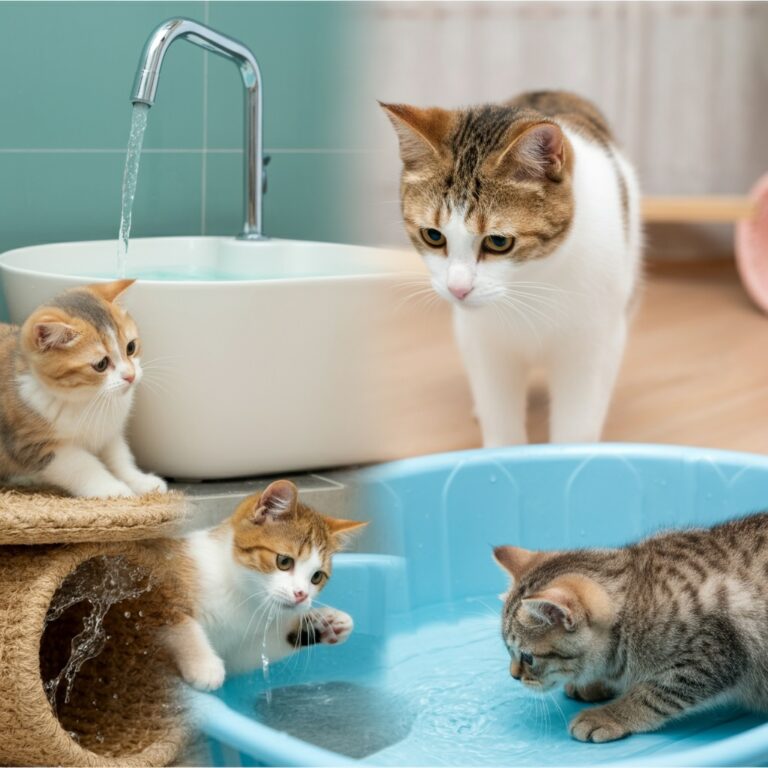
You’re working at your desk when suddenly, your pen goes flying. Your cat sits where the pen used to be, staring at you with those innocent eyes that seem to say, “What? I didn’t do anything.” Sound familiar? If you’re a cat owner, you’ve probably witnessed this scene countless times. Your feline friend seems to have an irresistible urge to push objects off tables, counters, and any elevated surface they can reach.
This behavior isn’t just random destruction or a personal vendetta against your belongings. There are fascinating scientific and evolutionary reasons why cats engage in this seemingly mischievous activity. Understanding these motivations can help you better appreciate your cat’s natural instincts and even find ways to redirect this behavior constructively.
From hunting instincts to curiosity-driven exploration, the reasons behind your cat’s table-clearing antics are more complex than you might think. Let’s explore the science behind this quintessential feline behavior and discover what your cat is really trying to tell you when they send your favorite mug crashing to the floor.
The Hunter’s Instinct: Predatory Behavior in Action
At its core, knocking objects off tables stems from your cat’s deeply ingrained hunting instincts. Even though your pampered indoor cat has never had to catch their own dinner, millions of years of evolution have hardwired them with predatory behaviors that surface in unexpected ways.
Testing for Prey
When cats encounter small objects on elevated surfaces, their first instinct is to investigate whether the item might be potential prey. A cat’s paw swipe serves as a test—if the object moves, it could be alive and worth pursuing. This behavior mimics how wild cats would test potentially dangerous prey items before committing to a full attack.
The initial gentle paw tap your cat gives to objects isn’t malicious; it’s methodical. They’re gathering information about texture, weight, and movement potential. If the object responds by rolling or sliding, it triggers their prey drive even further, leading to more aggressive batting until the item inevitably falls.
The Pounce and Bat Sequence
Wild cats use a specific hunting sequence: stalk, pounce, bat, and capture. Domestic cats retain this sequence but adapt it to their environment. Your coffee table becomes their hunting ground, and your pen becomes their prey. The batting motion that sends objects flying is actually a refined hunting technique designed to stun or disorient small animals.
This behavior is particularly pronounced in cats who don’t have adequate outlets for their hunting instincts. Indoor cats who rarely encounter real prey will redirect these powerful drives toward household objects, treating them as surrogate prey animals.
Curiosity and Exploration Drive Surface Investigation
Cats are naturally curious creatures, and their exploration methods often involve using their paws as primary investigative tools. Unlike humans, who rely heavily on vision and touch through our hands, cats gather information about their environment through multiple sensory channels, with their paws playing a crucial role.
Tactile Learning Through Paw Manipulation
A cat’s paws are incredibly sensitive, containing numerous nerve endings that provide detailed information about texture, temperature, and movement. When your cat encounters an unfamiliar object on a table, they’re not just being destructive—they’re conducting a thorough investigation.
This tactile exploration serves multiple purposes. Cats learn about object weight, surface texture, and structural integrity through paw manipulation. A lightweight pen will respond differently to a gentle tap than a heavy paperweight, and cats quickly learn to adjust their investigation techniques accordingly.
Environmental Mapping
Cats are territorial animals who maintain detailed mental maps of their environment. By interacting with objects on elevated surfaces, they’re updating their understanding of their territory. This behavior is particularly common when you’ve introduced new items to familiar spaces or rearranged furniture.
From your cat’s perspective, that new decorative bowl on your coffee table represents a change in their carefully catalogued environment. They need to investigate its properties, boundaries, and potential as either a resource or a threat. Unfortunately for your belongings, this investigation often involves testing how the object responds to physical manipulation.
Attention-Seeking Behavior and Social Communication
Many cat owners notice that their pets seem to knock things off tables more frequently when humans are present. This isn’t coincidence—it’s strategic behavior designed to elicit a response from their favorite humans.
Learning Human Response Patterns
Cats are excellent observers of human behavior and quickly learn which actions generate the strongest responses. If knocking your glasses off the nightstand results in immediate attention—even negative attention like scolding—your cat has learned a valuable lesson about human manipulation.
This attention-seeking behavior often develops gradually. Initially, your cat might knock something off accidentally while exploring. If you respond with animation, concern, or even frustration, you’ve inadvertently reinforced the behavior. Cats don’t distinguish between positive and negative attention; they simply recognize that the action generates a human response.
Communication Through Disruption
Cats have limited ways to communicate complex needs to their human companions. Knocking objects off surfaces can serve as a form of communication, particularly when more subtle signals have been ignored. Your cat might be trying to tell you they’re hungry, bored, or in need of attention.
This communication strategy is often most effective from your cat’s perspective because it’s impossible to ignore. While you might miss subtle meows or gentle head bumps, a crashing sound from the kitchen counter immediately captures your attention and brings you running.
Territorial Behavior and Space Claiming
Cats are highly territorial animals who feel compelled to establish and maintain control over their environment. Elevated surfaces hold particular appeal because they offer strategic advantages in terms of visibility, security, and territorial control.
Establishing Dominance Over Surfaces
When cats knock objects off tables and counters, they’re often engaged in territorial behavior. By removing human objects from elevated surfaces, cats are essentially claiming these spaces as their own. This behavior is particularly pronounced in multi-cat households where competition for prime real estate is intense.
Elevated surfaces represent premium territory in the feline world. They offer excellent vantage points for monitoring the environment, escape routes from potential threats, and comfortable resting spots away from ground-level disturbances. By clearing these surfaces of human belongings, cats are making room for their own occupancy.
Scent Marking Through Object Manipulation
Cats have scent glands in their paw pads, and the act of batting at objects leaves their scent behind. This subtle form of marking helps establish territorial boundaries and communicates information to other cats in the household. Even if you can’t detect these scent markers, other cats certainly can.
Continues after advertising
This scent-marking behavior serves as a form of feline social media, conveying information about who was in the area and when. For cats, leaving their scent on frequently used human surfaces reinforces their membership in the household social structure.
The Physics of Feline Surface Clearing
Understanding the physical mechanics of how cats knock things off tables can provide insight into why this behavior is so persistent and effective from their perspective.
Leverage and Force Application
Cats instinctively understand leverage, even if they can’t articulate the physics involved. When approaching objects on elevated surfaces, cats position themselves to maximize the effectiveness of their paw strikes. They often approach from angles that allow them to apply force in the direction that will most easily dislodge objects.
The design of most household surfaces actually facilitates this behavior. Smooth table tops, counters, and shelves provide minimal friction to prevent objects from sliding when struck. From your cat’s perspective, these surfaces are perfectly designed for object manipulation and removal.
Understanding Object Properties
Through repeated experimentation, cats develop sophisticated understanding of how different objects behave when manipulated. They learn that round objects will roll further than flat ones, that lightweight items move more easily than heavy ones, and that fragile objects produce more dramatic (and attention-getting) results when they hit the floor.
This learning process explains why some cats seem to target specific types of objects. They’re not necessarily being vindictive—they’re applying learned knowledge about which items are most likely to produce desired outcomes, whether that’s entertainment, attention, or territorial control.
Redirecting the Behavior: Working with Natural Instincts
Rather than fighting against your cat’s natural instincts, successful behavior modification involves redirecting these drives toward more appropriate outlets.
Environmental Enrichment Solutions
Providing dedicated spaces for your cat to engage their hunting and exploration instincts can significantly reduce destructive behavior. Cat trees with various levels, puzzle feeders, and interactive toys give cats appropriate outlets for their need to bat, pounce, and manipulate objects.
Consider creating designated “cat surfaces” where your pet is welcome to explore and manipulate objects safely. A low table with cat-appropriate items like ping pong balls, small toys, or cardboard boxes can satisfy their urge to investigate elevated surfaces without endangering your belongings.
Strategic Object Placement
Understanding your cat’s motivations allows you to make strategic decisions about object placement. Valuable or fragile items should be stored in closed cabinets or areas your cat cannot access. Meanwhile, less important objects can be secured with museum putty or double-sided tape to discourage manipulation.
Creating physical barriers doesn’t mean giving up your living space to your cat. Instead, it means being strategic about which battles are worth fighting and which can be avoided through thoughtful environmental design.
When Surface Clearing Becomes Problematic
While occasional object-knocking is normal feline behavior, excessive or suddenly increased surface clearing can indicate underlying issues that need attention.
Signs of Stress or Anxiety
Cats experiencing stress or anxiety may increase territorial behaviors, including aggressive surface clearing. Major life changes like moving, new pets, or changes in routine can trigger increased object-knocking behavior as cats attempt to reassert control over their environment.
If your previously well-behaved cat suddenly begins systematically clearing surfaces, consider recent changes in their environment or routine. Addressing underlying stressors often reduces the problematic behavior more effectively than direct intervention.
Health Considerations
Sudden changes in behavior patterns can sometimes indicate health issues. Cats experiencing pain, cognitive decline, or sensory changes may alter their interaction patterns with their environment. If behavior changes are dramatic or accompanied by other symptoms, consult with your veterinarian to rule out medical causes.
Vision problems, arthritis, or cognitive dysfunction can all influence how cats navigate and interact with elevated surfaces. What appears to be increased mischievousness might actually be a cat struggling to adapt to physical limitations.
Building a Cat-Friendly Home That Works for Everyone
The key to harmonious coexistence with a surface-clearing cat lies in understanding and accommodating their natural behaviors while protecting your belongings and maintaining your living space.
Creating Compromise Zones
Successful cat households often feature compromise zones—areas where cats are welcome to engage their natural behaviors without causing problems for human occupants. This might include designated climbing areas, cat-specific furniture, or surfaces where exploration is encouraged rather than discouraged.
By providing appealing alternatives to your dining room table or office desk, you give your cat choices about where to engage their investigative behaviors. Most cats will choose the option that provides the most interest and stimulation, especially if it’s specifically designed for their needs.
Training and Positive Reinforcement
While you can’t completely eliminate your cat’s instinct to investigate elevated surfaces, you can influence their choices through consistent training and positive reinforcement. Rewarding your cat for using appropriate surfaces while gently redirecting them from forbidden areas helps establish clear boundaries.
Remember that punishment rarely works effectively with cats and can damage your relationship. Instead, focus on making appropriate behaviors more rewarding and appealing than inappropriate ones.
Read More👉 5 Simple Exercises to Keep Your Senior Pet Active and Mobile
Understanding Your Feline Companion’s True Nature
The next time you watch your pen sail off your desk courtesy of a feline paw, remember that you’re witnessing millions of years of evolution in action. Your cat isn’t plotting against you or deliberately trying to cause chaos—they’re simply being authentically feline.
This behavior connects your pampered house cat to their wild ancestors and serves important psychological and physical functions. By understanding and respecting these natural drives, you can create a living environment that satisfies both your needs for an orderly home and your cat’s needs for exploration, territory, and stimulation.
The relationship between cats and humans has always required compromise and understanding. Accepting your cat’s surface-clearing tendencies as a natural behavior rather than a personal affront allows you to address the behavior constructively while deepening your appreciation for the complex, fascinating creature sharing your home.
Rather than viewing knocked-off objects as evidence of feline misbehavior, try seeing them as proof that your cat feels comfortable and confident in their territory—comfortable enough to engage in natural behaviors that have served their species well for millennia. With proper environmental enrichment, strategic planning, and a healthy dose of humor, you and your surface-clearing cat can coexist peacefully while honoring both your human needs and their feline instincts.






